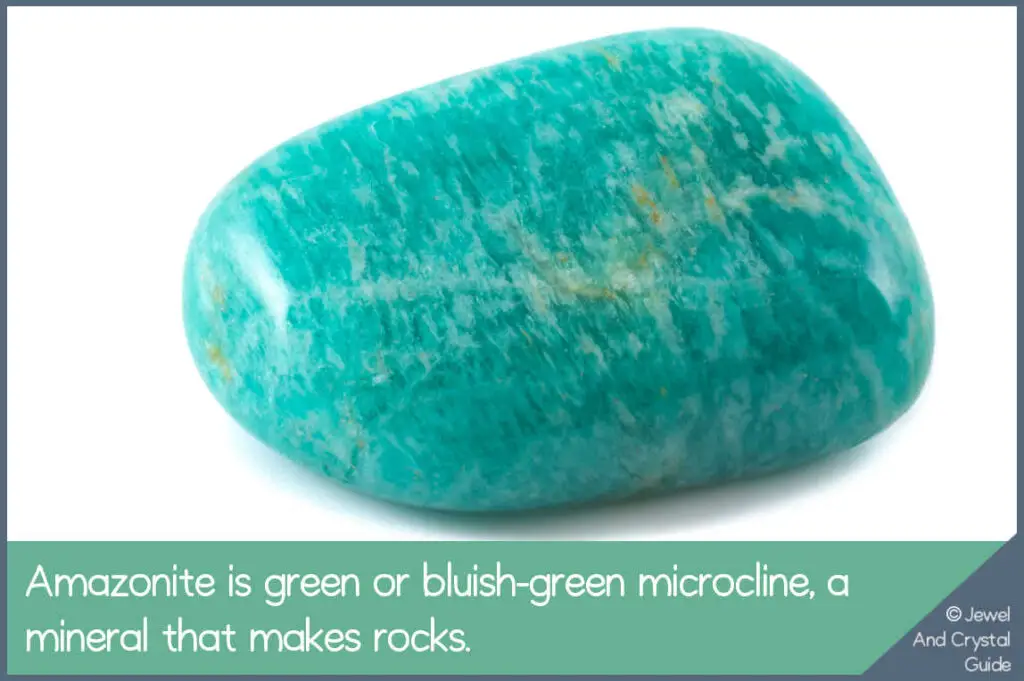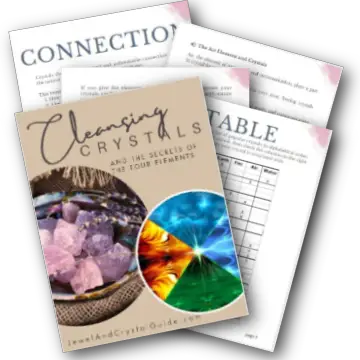
What is amazonite
Amazonite is a microcline crystal that belongs to the feldspar family. Feldspars are minerals that form rocks. There’s a lot of feldspar in the Earth’s crust because of how rocks and amazonite form together from lava.
Amazonite is known for its green to greenish-blue color that resembles green stones found in the Amazon rainforest a long time ago. In fact, some say this is where the name comes from (more on that later).
Different colors of microcline are called different things, but only green microcline can be called amazonite.
Amazonite is available in various shapes and sizes, either as raw pieces or polished gemstones. The crystal is widely used in jewelry-making, such as necklaces, bracelets, and rings, because of its beauty.
What amazonite is good for
Amazonite is good for anyone looking for peace and emotional balance. Whether you’re facing a stressful situation, dealing with challenging emotions, or wanting better communication in your relationships, amazonite brings a comforting embrace.
Amazonite has a strong spiritual history dating back to the ancient Egyptians, who used it as a symbol for protection and fertility. And the story doesn’t end there as the crystal’s spiritual meaning is just as strong today as ever before.
This makes amazonite is a wonderful crystal for self-discovery and personal growth, bringing harmony to your mind, body, and spirit.
Here’s my complete list of what amazonite is good for and what it will bring you.
Other names for amazonite
Amazonite is usually just called amazonite but here’s a list of names people might call this crystal:
- Amazonite: Amazonite is the most common name for green microcline feldspar. Some say amazonite is called amazonite because green stones had previously been found near the Amazon river. Others say the name is simply a marketing tactic to make people like you and me want to buy an exotic-sounding crystal.
- Amazon stone: The name “Amazon stone” shows the crystal’s association with the Amazon region. The word “stone” is often used to describe minerals and gemstones, including crystals.
- Amazon jade: Some sellers call amazonite “Amazon jade” when it looks like jade, to make buyers think the crystal is worth more than regular amazonite. But amazonite and jade are different minerals and cannot be the same thing, even though they are both green and might look quite similar.
- Amazonite feldspar: Amazonite is a type of feldspar, and feldspar is a common mineral in rocks in the Earth’s crust. Adding the word “feldspar” to the name simply highlights what family of minerals amazonite belongs to.
- Pikes Peak Jade or Colorado Jade: Amazonite found near Pikes Peak mountain or Colorado in the US is often referred to as Pikes Peak Jade or Colorado Jade. These names tell you where the amazonite was found, and the name “jade” comes from the fact that amazonite can look like jade.
Colors of amazonite
Amazonite is the green to blue-green variety of microcline feldspar. It cannot and does not come in any other color.
Other colors of feldspar have their own name, and they are not amazonite.

Amazonite gets its green color from lead and water. I explain the process of how the crystal forms and gets its color in this blog post.
Amazonite often has white streaks or lines in it. These white markings are from another mineral, called albite, which got into the crystal while it formed.

Amazonite versus other crystals
The difference between amazonite and turquoise
Amazonite and turquoise are completely different crystals, though both crystals are shades of greens and blues.
Turquoise is a hydrous phosphate crystal, made up of copper and aluminum. It’s blue to greenish-blue, is opaque so it lets no light through, and it often has dark brown or black markings on it.

Amazonite is a green to blue-green microcline feldspar crystal, and it often has white streaks of albite feldspar running through it.
Amazonite often lets no light through but it can let some light through in thinner areas, so we say it’s opaque to semi-translucent.
Find out more about the differences between amazonite and turquoise in my easy guide here.
The difference between amazonite and aventurine
Amazonite and aventurine are different crystals, even though they’re both shades of green.
Aventurine is quartz crystal that’s made up of silicon and oxygen, along with other mineral inclusions, such as fuschite.

Amazonite is a type of feldspar called microcline, and it’s mainly made up of potassium, aluminum, silicon, and oxygen.
Is amazonite expensive?
Like all crystals, the cost of amazonite depends on the quality, color, and size of the piece, as well as how many people want to buy it and how much is available.
A medium-quality amazonite crystal costs about $4 to $16 per gram. Amazonite is not as expensive as some other gemstones, but high-grade amazonite will set you back up to $30 or more per gram.
Here is a table with the average price ranges of amazonite per gram:
| Quality | Average Price Range Per Gram (USD) |
| Low-grade amazonite | $2 – $6 |
| Medium-grade amazonite | $4 – $16 |
| High-grade amazonite | $10 – $30+ |
Where to keep amazonite
The best places to keep amazonite are on your body near your heart chakra, in your bedroom, in your car or travel bag, and in your bedroom. Put amazonite wherever you need to feel calmer, more balanced, and focused.
Click here to get all my ideas on where to keep your amazonite and why.
How to cleanse and charge amazonite
Amazonite can be cleansed and charged in nature using earth, fire, wind, or water. Put the crystal in healthy soil, the smoke of a burning smudge or incense stick, in sunlight, or in your own breath to purify and revitalize it.
Here’s a list with instructions on all the ways to safely cleanse and charge amazonite.
Once you’ve charged your amazonite, it’s good to meditate with the crystal (here’s a simple but effective meditation to try) and use affirmations like these to ask the crystal for what you need.
How to tell if amazonite is real
If you have an amazonite crystal and you want to know if it’s authentic, then the best way to tell is by looking at it and doing some simple tests.
Real amazonite is green or bluish-green, bubbles in vinegar, is opaque to semi-translucent, scratches glass, and sinks in water.

These are all things you can do to test a crystal at home, but a certified lapidist or jeweler can confirm your findings.
Here’s a list of ways to tell whether an amazonite crystal is genuine or fake.
Who should wear amazonite
While anyone can wear amazonite, Aries, Taurus, and Cancer are believed to benefit most from wearing this crystal due to your astrological properties.
Amazonite addresses your specific challenges and enhances your strengths, bringing inner peace, stability, and balance into your life.
Here’s what each zodiac sign gets from wearing amazonite
Want to remember this? Save this post on A Guide To Amazonite to your favorite Pinterest Board below!












